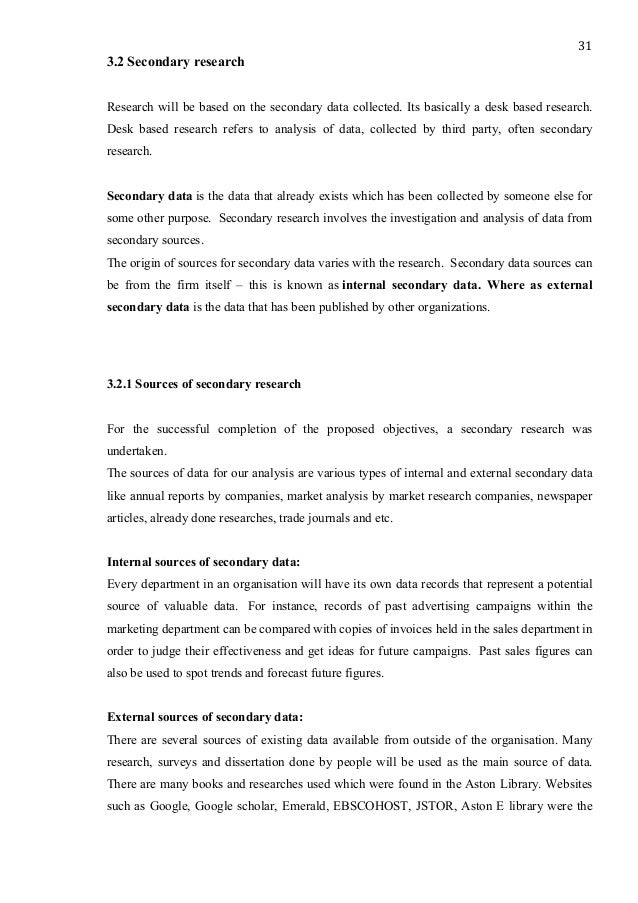
Secondary data is another type of quantitative data that has already been collected by someone else for another study some time back. It is the most widely used method of data collection, as a researcher can get more polished data. While it is secondary data for you, it is actually primary data for the person who collected it originally You may be asked to craft a dissertation based on secondary research. This will require you to use different methods if compared to primary research. In order to conduct a proper study and write a strong thesis, you’ll need to follow a number of particular steps. Crafting a Dissertation Based on Secondary Research. Pick a topic Preparing Secondary Data. • Step 3: Recode variables – Reverse code negatively worded items if creating scale scores – Dummy code dichotomous variables into values of 0, 1 (original dataset may use values of 1, 2) – Recode other categorical variables (e.g., dummy or effect coding) – Combine separate but like variables • E.g., ECLS-B contained 2 kindergarten waves (only 75% of children were in File Size: 1MB
Example Of Research Paper Using Secondary Data Pdf - Floss Papers
Secondary research is research that has already been carried out and collected by someone else. Thankfully secondary will save you time in the long run! Read more about the advantages and disadvantages of primary research. Some good places to search include:. You might be looking for one more specifically than the other, or you could use a mix of dissertation using secondary data. The type of data you want to be captured in your dissertation will depend on your overarching question — so keep it in mind throughout your search!
We recommend splitting this into chapters with subheadings and ensuring that each point you want to discuss has a reliable source to back it up.
Just make sure you prioritise the research that backs up your overall point so each section has clarity. In your intro, you will want to emphasise what your dissertation aims to cover within your writing and outline your research objectives. You can then follow up with the context around this question and identify why your research is meaningful to a wider audience.
Before you get started on the main chapters of your dissertation, you need to find out what theories relate to your chosen subject and the research that has already been carried out around it.
Your literature dissertation using secondary data will be a summary of any previous research carried out on the topic and should have an intro and conclusion like any other body of the academic text.
When writing about this research you want to make sure you are describing, summarising, evaluating and analysing each piece. This is one crucial way to score some marks. You also want to dissertation using secondary data any themes between each piece of research to emphasise their relevancy. It will form your main chapters after your lit review.
The most important part is that you use it wisely. To finish off the theoretical framework you want to start suggesting where your research will fit in with those texts in your literature review. You might want to challenge a theory by critiquing it with another or explain how two theories can be combined to make a new outcome.
A great way to avoid repetition is to highlight any overarching themes your conclusions have shown. Hopefully, this helps you with your secondary data research for your dissertation!
You may also want to read about the advantages and disadvantages of secondary dissertation using secondary data. Writing Services Essay Writing Assignment Writing Coursework Writing Annotated Bibliography Case Study Writing Literature Review Writing Report Writing Reflective Report Writing Research Proposal Model Answers Exam Notes, dissertation using secondary data. Why choose us? Mission and Vision Samples Library Referral Programme FAQs Contact Us.
Manage Orders Sign Out. Write Your Dissertation Using Only Secondary Research. November by Keira Bennett. Previous Post Next Post, dissertation using secondary data. You may also like Advantages of Secondary Research Disadvantages of Secondary Research How to Analyse Secondary Data for a Dissertation Start Your Dissertation Research Over Summer Discover Your Learning Style and Master Your Studies How To Apply Ethics to Your Research.
Online Chat WhatsApp Messenger Email, dissertation using secondary data. We value your privacy. We do not sell your data and do not resell our papers.
We use cookies which you can view and control.
Primary vs. Secondary Sources: The Differences Explained - Scribbr ��
, time: 4:13How to Analyse Secondary Data for a Dissertation
Jan 14, · Secondary research process in 4 steps Step 1: Develop your research question (s) Secondary research begins exactly like any type of research: by developing Step 2: Identify a secondary data set As we mentioned above, most research begins by specifying what is already known on Step 3: Evaluate Dissertation Using Only Secondary Data Examples. An Introduction to Secondary Data Analysis - National Center for Analysis of secondary data, where “ secondary data can include any data that are examined to answer Ideal for use in classroom examples, semester projects, masters theses, dissertations, supplemental studies Secondary data is another type of quantitative data that has already been collected by someone else for another study some time back. It is the most widely used method of data collection, as a researcher can get more polished data. While it is secondary data for you, it is actually primary data for the person who collected it originally
No comments:
Post a Comment